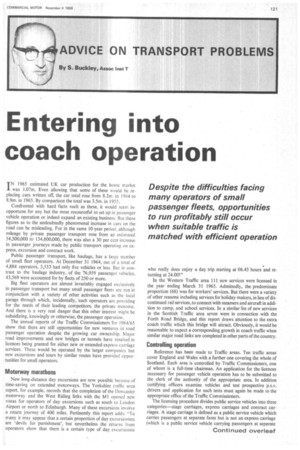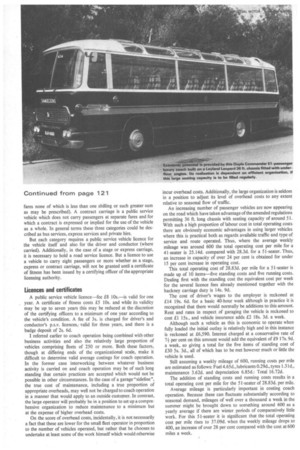Entering into coach operation
Page 123

Page 124

If you've noticed an error in this article please click here to report it so we can fix it.
Despite the difficulties facing many operators of small passenger fleets, opportunities to run profitably still occur when suitable traffic is matched with efficient operation
TN 1965 estimated UK car production for the home market was 1.07m. Even allowing that some of these would be replacing cars written off, the car total rose from 8.2m. in 1964 to 8.9m. in 1965. By comparison the total was 3.5m. in 1955.
Confronted with hard facts such as these, it would seem inopportune for any but the most resourceful to set up in passenger vehicle operation or indeed expand an existing business. But these figures as to the undoubtedly phenomenal increase in cars on the road can be misleading. For in the same 10-year period, although mileage by private passenger transport rose from an estimated 54,300,000 to 134,800,000, there was also a 30 per cent increase in passenger journeys made by public transport operating on express, excursion and contract work.
Public passenger transport, like haulage, has a large number of small fleet operators. At December 31 1964, out of a total of 4,884 operators, 3,533 had only five vehicles or less. But in contrast to the haulage industry, of the 76,959 passenger vehicles, 43,569 were accounted for by fleets of 250 or more.
Big fleet operators are almost invariably engaged exclusively in passenger transport but many small passenger fleets are run in conjunction with a variety of other activities such as the local garage through which, incidentally, Such operators are providing for the needs of their leading competitors, the private motorist. And there is a very real danger that this other interest might be subsidizing, knowingly or otherwise, the passenger operation.
The annual reports of the Traffic Commissioners for 1964/65 show that there are still opportunities for new ventures in road passenger operation despite the growing car ownership. Major road improvements and new bridges or tunnels have resulted in licences being granted for either new or extended express carriage services. These would be operated by the larger companies but new excursions and tours by similar routes have provided opportunities for small operators.
Motorway marathons New long-distance day excursions are now possible because of time-saving on extended motorways. The Yorkshire traffic area report, for example, records that the completion of the Doncaster motorway and the West Riding links with the MI opened new vistas for operators of day excursions such as south to London Airport or north to Edinburgh. Many of these excursions involve a return journey of 400 miles. Pertinently this report adds: "To many it may appear that a certain proportion of day excursionists are 'devils for punishment', but nevertheless the returns from operators show that there is a certain type of day excursionist
who really does enjoy a day trip starting at 06.45 hours and returning at 24.001"
In the Western Traffic area 111 new services were licensed in the year ending March 31 1965. Admittedly, the predominate proportion (66) was for workers' services. But there were a variety of other reasons including services for holiday-makers, in lieu of discontinued rail services, to connect with steamers anclaircraft in addition to camp, and school services. In a similar list of new services in the Scottish Traffic area seven were in connection with the Forth Road Bridge, and this report draws attention to the extra coach traffic which this bridge will attract. Obviously, it would be reasonable to expect a corresponding growth in coach traffic when similar major road links are completed in other parts of the country.
Controlling operation
Reference has been made to Traffic areas. Ten traffic areas cover England and Wales with a further one covering the whole of Scotland. Each area is controlled by Traffic Commissioners, one of whom is a full-time chairman. An application for the licences necessary for passenger vehicle operation has to be submitted to the clerk of the authority of the appropriate area. In addition certifying officers examine vehicles and test prospective p.s.v. drivers and application for such tests must again be made to the appropriate office of the Traffic Commissioners.
The licensing procedure divides public service vehicles into three categories—stage carriages, express carriages and contract carriages. A stage carriage is defined as a public service vehicle which carries passengers at separate fares but is not an express carriage (which is a public service vehicle carrying passengers at separate fares none of which is less than one shilling or such greater sum as may be prescribed). A contract carriage is a public service vehicle which does not carry passengers at separate fares and for which a contract is expressed or implied for the use of the vehicle as a whole. In general terms these three categories could be described as bus services, express services and private hire.
But each category requires a public service vehicle licence for the vehicle itself and also for the driver and conductor (where carried). Additionally, in the case of a stage or express carriage, it is necessary to hold a road service licence. But a licence to use a vehicle to carry eight passengers or more whether as a stage, express or contract carriage, will not be granted until a certificate of fitness has been issued by a certifying officer of the appropriate licensing authority.
Licences and certificates A public service vehicle licence—fee £8 10s.—is valid for one year. A certificate of fitness costs £5 10s. and while its validity may be up to seven years this may be reduced at the discretion of the certifying officers to a minimum of one year according to the vehicle's condition. A fee of 3s. is charged for driver's and conductor's p.s.v. licences, valid for three years, and there is a badge deposit of 2s. 6d.
I referred earlier to coach operation being combined with other business activities and also the relatively large proportion of vehicles comprising fleets of 250 or more. Both these factors, though at differing ends of the organizational scale, make it difficult to determine valid average costings for coach operation. In the former case interworking between whatever business activity is carried on and coach operation may be of such long standing that certain practices are accepted which would not be possible in other circumstances. In the case of a garage "sideline", the true cost of maintenance, including a true proportion of appropriate overheads, may well not be charged to coach operation in a manner that would apply to an outside customer. In contrast, the large operator will probably be in a position to set up a comprehensive organization to reduce maintenance to a minimum but at the expense of higher overhead costs.
On the score of overhead costs, incidentally, it is not necessarily a fact that these are lower for the small fleet operator in proportion to the number of vehicles operated, but rather that he chooses to undertake at least some of the work himself which would otherwise incur overhead costs. Additionally, the large organization is seldom in a position to adjust its level of overhead costs to any extent relative to seasonal flow of traffic.
An increasing number of passenger vehicles are now appearing on the road which have taken advantage of the amended regulations permitting 36 ft. long chassis with seating capacity of around 51. With such a high proportion of labour cost in total operating costs there are obviously economic advantages in using larger vehicles where this is practical both as regards available traffic and type of service and route operated. Thus, where the average weekly mileage was around 600 the total operating cost per mile for a 41-seater is 25.14d. compared with 28.3d. for a 51-seater. Thus, an increase in capacity of over 24 per cent is obtained for under 15 per cent increase in operating cost.
This total operating cost of 28.83d. per mile for a 51-seater is made up of 10 items—five standing costs and five running costs. Dealing first with the standing cost the equivalent cost per week for the several licence fees already mentioned together with the hackney carriage duty is 14s. 9d.
The cost of driver's wages to the employer is reckoned at £14 19s. 6d. for a basic 40-hour week although in practice it is recognized that there would normally be additions to this amount. Rent and rates in respect of garaging the vehicle is reckoned to cost £1 15s., and vehicle insurance adds £2 18s. 3d. a week.
Although such a vehicle as this is economic to operate when fully loaded the initial outlay is relatively high and in this instance is reckoned at £6,590. Interest charged at a conservative rate of 74 per cent on this amount would add the equivalent of £9 17s. 9d. a week, so giving a total for the five items of standing cost of £30 5s. 3d., all of which has to be met however much or little the vehicle is used.
Still assuming a weekly mileage of 600, running costs per mile are estimated as follows: Fuel 4.65d., lubricants 0.29d., tyres 1.314., maintenance 3.62d. and depreciation 6.85d.: Total 16.72d.
The addition of standing costs and running costs results in a total operating cost per mile for the 51-seater of 28.83d. per mile.
Average mileage is particularly important in costing coach operation. Because these can fluctuate substantially according to seasonal demand, mileages of well over a thousand a week in the summer might be brought down to something around 600 as a yearly average if there are winter periods of comparatively little work. For this 51-seater it is significant that the total operating cost per mile rises to 37.09d. when the weekly mileage drops to 400, an increase of over 28 per cent compared with the cost at 600 miles a week.








































































































































































